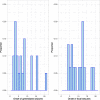Clinical, genetic, and cognitive correlates of seizure occurrences in Phelan-McDermid syndrome
- PMID: 38730350
- PMCID: PMC11084001
- DOI: 10.1186/s11689-024-09541-0
Clinical, genetic, and cognitive correlates of seizure occurrences in Phelan-McDermid syndrome
Abstract
Background: Phelan-McDermid syndrome (PMS) is a genetic neurodevelopmental disorder caused by SHANK3 haploinsufficiency and is associated with an increased risk for seizures. Previous literature indicates that around one third of individuals with PMS also have epilepsy or seizures, with a wide range of types and ages of onset. Investigating the impact of seizures on intellectual and adaptive functioning for PMS is a primary concern for caregivers and is important to understanding the natural history of this syndrome.
Methods: We report on results from 98 individuals enrolled in a prospective, longitudinal study. We detailed seizure frequency, type, and age of onset, and we analyzed seizure occurrence with best estimate IQ, adaptive functioning, clinical features, and genotype. We conducted multiple linear regression analyses to assess the relationship between the presence of seizures and the Vineland Adaptive Behavior Scale, Second Edition (VABS-II) Adaptive Behavior Composite score and the best estimate full-scale IQ. We also performed Chi-square tests to explore associations between seizure prevalence and genetic groupings. Finally, we performed Chi-square tests and t-tests to explore the relationship between seizures and demographic features, features that manifest in infancy, and medical features.
Results: Seizures were present in 41% of the cohort, and age of onset was widely variable. The presence of seizures was associated with significantly lower adaptive and intellectual functioning. Genotype-phenotype analyses were discrepant, with no differences in seizure prevalence across genetic classes, but with more genes included in deletions of participants with 22q13 deletions and seizures compared to those with 22q13 deletions and no seizures. No clinical associations were found between the presence of seizures and sex, history of pre- or neonatal complications, early infancy, or medical features. In this cohort, generalized seizures were associated with developmental regression, which is a top concern for PMS caregivers.
Conclusions: These results begin to eludicate correlates of seizures in individuals with PMS and highlight the importance of early seizure management. Importantly, presence of seizures was associated with adaptive and cognitive functioning. A larger cohort might be able to identify additional associations with medical features. Genetic findings suggest an increased capability to realize genotype-phenotype relationships when deletion size is taken into account.
Keywords: 22q13; Epilepsy; Phelan-McDermid syndrome; SHANK3; Seizures.
© 2024. The Author(s).
Conflict of interest statement
The authors declare no competing interests.
Figures




References
-
- García-Bravo C, Martínez-Piédrola RM, García-Bravo S, Rodríguez-Pérez MP, Martín-Gómez AS, Fernández-Gómez G, Palacios-Ceña D. Living with and managing seizures among parents of children diagnosed with Phelan-McDermid syndrome: a qualitative study using in-depth interviews. Eur J Pediatr. 2023. 10.1007/s00431-023-05285-6. - PubMed
Publication types
MeSH terms
Substances
Supplementary concepts
Grants and funding
LinkOut - more resources
Full Text Sources
Medical

